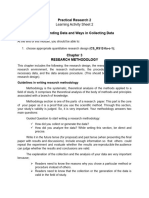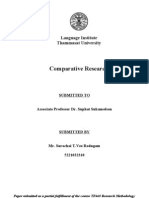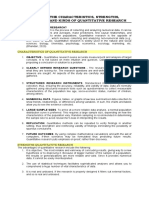Test 5 Socio
Test 5 Socio
Uploaded by
Aditi SoniCopyright:
Available Formats
Test 5 Socio
Test 5 Socio
Uploaded by
Aditi SoniOriginal Title
Copyright
Available Formats
Share this document
Did you find this document useful?
Is this content inappropriate?
Copyright:
Available Formats
Test 5 Socio
Test 5 Socio
Uploaded by
Aditi SoniCopyright:
Available Formats
RESEARCH DESIGN
Research design is the framework of research methods and techniques chosen by a researcher to
conduct a study. The design allows researchers to sharpen the research methods suitable for the
subject matter and set up their studies for success. The types of research design are:
1. Descriptive: In a descriptive composition, a researcher is solely interested in describing the
situation or case under their research study. It is a theory-based design method created by
gathering, analyzing, and presenting collected data. This allows a researcher to provide insights
into the why and how of research. Descriptive design helps others better understand the need for
the research. If the problem statement is not clear, you can conduct exploratory research.
2. Experimental: Experimental research establishes a relationship between the cause and effect
of a situation. It is a causal research design where one observes the impact caused by the
independent variable on the dependent variable. For example, one monitors the influence of an
independent variable such as a price on a dependent variable such as customer satisfaction or
brand loyalty. It is an efficient research method as it contributes to solving a problem.
3. Correlational research: Correlational research is a non-experimental research technique. It
helps researchers establish a relationship between two closely connected variables. There is no
assumption while evaluating a relationship between two other variables, and statistical analysis
techniques calculate the relationship between them. This type of research requires two different
groups.
A correlation coefficient determines the correlation between two variables whose values range
between -1 and +1. If the correlation coefficient is towards +1, it indicates a positive relationship
between the variables, and -1 means a negative relationship between the two variables.
4. Diagnostic research: In diagnostic design, the researcher is looking to evaluate the
underlying cause of a specific topic or phenomenon. This method helps one learn more about the
factors that create troublesome situations.
This design has three parts of the research:
Inception of the issue
Diagnosis of the issue
Solution for the issue
5. Explanatory research: Explanatory design uses a researcher’s ideas and thoughts on a
subject to further explore their theories. The study explains unexplored aspects of a subject and
details the research questions’ what, how, and why.
6. Exploratory research: Exploratory research is defined as a research used to investigate a
problem which is not clearly defined. It is conducted to have a better understanding of the
existing research problem, but will not provide conclusive results. For such a research, a
researcher starts with a general idea and uses this research as a medium to identify issues, that
can be the focus for future research.
SAMPLE
According to Manheim, “ A sample is the part of population which is studied in order to make
inferences about the whole population.
Bailey has said that the experienced researcher starts from the top(Population ) and worked down
to bottom(sample). They get a clear picture of the population before selecting the sample
PURPOSES OF SAMPLING
1. Cost-Efficiency: Sampling allows researchers to collect data from a smaller portion of
the population, reducing the time, effort, and resources needed compared to studying the
entire population. This is particularly beneficial when the population is large or widely
dispersed.
2. Time-Saving: Sampling helps save time by allowing researchers to collect data more
quickly than if they were to study the entire population. This is especially important when
timely decisions need to be made or when conducting studies with deadlines.
3. Accuracy: When done correctly, sampling can provide accurate estimates of population
parameters. Statistical techniques can be used to ensure that the sample is representative
of the population, minimizing bias and errors.
4. Feasibility: In some cases, it may be impractical or impossible to study the entire
population due to logistical constraints. Sampling makes it feasible to gather data in such
situations.
5. Inference: Sampling allows researchers to make inferences about the population based
on the characteristics observed in the sample. By analyzing the sample data, researchers
can draw conclusions and make predictions about the population as a whole.
6. Risk Reduction: Sampling can help mitigate risks associated with data collection. If
errors occur or if there are issues with the sample, the impact is limited to the subset
studied, rather than affecting the entire population.
You might also like
- Ebook PDF Creating Meaning Through Literature and The Arts Arts Integration For Classroom Teachers 5th Edition PDFDocument41 pagesEbook PDF Creating Meaning Through Literature and The Arts Arts Integration For Classroom Teachers 5th Edition PDFmaria.warner87693% (56)
- International Encylopedia of Social & Behavioral SciencesDocument222 pagesInternational Encylopedia of Social & Behavioral Sciencesnayamill89% (9)
- Module 3 Chapter 3.Document14 pagesModule 3 Chapter 3.Patty BoneoNo ratings yet
- Research Methodology: Johnsons and JonhsonDocument64 pagesResearch Methodology: Johnsons and JonhsonTeena VarmaNo ratings yet
- Internship Supervisor CommentsDocument6 pagesInternship Supervisor Commentsenzong16No ratings yet
- КТП 2 класс 2022-2023Document9 pagesКТП 2 класс 2022-2023TEMIRBULATOVICHNo ratings yet
- Business Research Methods NotesDocument106 pagesBusiness Research Methods NotesAce Emil100% (2)
- Development of SociologyDocument17 pagesDevelopment of Sociologyfafoje8944No ratings yet
- Chapter 2: Methods of Educational ResearchDocument7 pagesChapter 2: Methods of Educational ResearchIqra MunirNo ratings yet
- Unit 5 SociologyDocument2 pagesUnit 5 SociologyMukul KumarNo ratings yet
- Chapter 2 ModuleDocument34 pagesChapter 2 ModuleMissy DanielsNo ratings yet
- CHAPTER 3: Research MethodologyDocument10 pagesCHAPTER 3: Research Methodologysaksham sharmaNo ratings yet
- Social Research 05032023 113509pmDocument12 pagesSocial Research 05032023 113509pmGhayyur MehdiNo ratings yet
- Sheila - Research DesignDocument31 pagesSheila - Research DesignchristopherNo ratings yet
- Basic Research Method in Social ScienceDocument91 pagesBasic Research Method in Social ScienceSagar Sunuwar100% (1)
- Lesson 4Document13 pagesLesson 4ERLINDA PALACIONo ratings yet
- Research Methodology: 571216 Business Research Methods Unit - IDocument13 pagesResearch Methodology: 571216 Business Research Methods Unit - IDeepa DilNo ratings yet
- PR2 LAS2 Research DesignDocument8 pagesPR2 LAS2 Research Designraylinecastro21No ratings yet
- The Basic Concepts of Quantitative Research DesignDocument10 pagesThe Basic Concepts of Quantitative Research DesignCaca100% (1)
- Practical Research 2 - Chap.3Document28 pagesPractical Research 2 - Chap.3wendell john medianaNo ratings yet
- 33333333Document11 pages33333333Marivic Betis RubidoNo ratings yet
- Practical Research 2: Quarter 1, Week 1Document37 pagesPractical Research 2: Quarter 1, Week 1JOHN KENNETH MANOZONNo ratings yet
- Research DesignsDocument6 pagesResearch DesignsJay-ar MasulotNo ratings yet
- Comparative Research TDocument8 pagesComparative Research TpratoomsriNo ratings yet
- MMR Answers CompiledDocument26 pagesMMR Answers CompiledRaghav GargNo ratings yet
- Smit Prakash, Asociate Software Engineer at IBM (2016-Present)Document5 pagesSmit Prakash, Asociate Software Engineer at IBM (2016-Present)Kiran DNo ratings yet
- Research Design Definition Characteristics and TypesDocument3 pagesResearch Design Definition Characteristics and TypesManjit KaurNo ratings yet
- PR2 Module1Document13 pagesPR2 Module1Ronnie DalgoNo ratings yet
- Basic Research Method in Social ScienceDocument23 pagesBasic Research Method in Social ScienceSagar SunuwarNo ratings yet
- STM 327 Note 2021Document19 pagesSTM 327 Note 20218rmy44w9g6No ratings yet
- PR2 Week-1-StudentsDocument23 pagesPR2 Week-1-StudentsLee Andrew Añonuevo CajuelanNo ratings yet
- PR2 Lesson 1Document5 pagesPR2 Lesson 1Marcco Juan MarccoNo ratings yet
- 1 What Is ResearchDocument5 pages1 What Is ResearchshbhukeleNo ratings yet
- MBR MethodologyDocument4 pagesMBR Methodologyrahila akNo ratings yet
- Research Methods MPC 005Document21 pagesResearch Methods MPC 005shaila colacoNo ratings yet
- Quantitative Research: Module 1: The Nature of Inquiry and ResearchDocument19 pagesQuantitative Research: Module 1: The Nature of Inquiry and Researchmargilyn ramosNo ratings yet
- Quantitative Research: Module 1: The Nature of Inquiry and ResearchDocument19 pagesQuantitative Research: Module 1: The Nature of Inquiry and ResearchMargilyn RamosNo ratings yet
- Lesson 1Document7 pagesLesson 1Christian David Comilang CarpioNo ratings yet
- Research Methods..... Notes ?Document6 pagesResearch Methods..... Notes ?chrysanthemumkamauNo ratings yet
- Research Design ExampleDocument2 pagesResearch Design ExampleJay TabuelogNo ratings yet
- Mims PR2 LC1 Quantitative ResearchDocument11 pagesMims PR2 LC1 Quantitative ResearchJester Guballa de LeonNo ratings yet
- Research Design DefinitionDocument7 pagesResearch Design Definitionstudent0990No ratings yet
- Quantitative ResearchDocument4 pagesQuantitative ResearchEve JohndelNo ratings yet
- Pr2 Module 1Document57 pagesPr2 Module 1Joseph ObraNo ratings yet
- Research Methology AssignmentDocument9 pagesResearch Methology AssignmentZoya KhanNo ratings yet
- Review On Criminological ResearchDocument64 pagesReview On Criminological ResearchTIPAY, EMELIE L.100% (2)
- Activity 1Document5 pagesActivity 1Vincent MoralesNo ratings yet
- Module 3: Nature and Inquiry OF ResearchDocument14 pagesModule 3: Nature and Inquiry OF ResearchJohn PaulNo ratings yet
- First Quarter LessonsDocument6 pagesFirst Quarter LessonsshinnnnkagenouNo ratings yet
- Rma ReviewerDocument7 pagesRma ReviewerPatricia de los SantosNo ratings yet
- Research Design in Quantitative MethodDocument39 pagesResearch Design in Quantitative MethodEunho KimNo ratings yet
- IT Chapter 4 2015Document30 pagesIT Chapter 4 2015Dawit SebhatNo ratings yet
- Business Research Method The Design of ResearchDocument18 pagesBusiness Research Method The Design of ResearchFaisal Raheem ParachaNo ratings yet
- Lesson-1Document3 pagesLesson-1levietemplado141No ratings yet
- Lesson 1: The Characteristics, Strengths, Weaknesses, and Kinds of Quantitative ResearchDocument8 pagesLesson 1: The Characteristics, Strengths, Weaknesses, and Kinds of Quantitative ResearchAlma Cecilia Quiao100% (2)
- Balasta-Research Design For Language TeachingDocument6 pagesBalasta-Research Design For Language TeachingGoshen ShamaSelahNo ratings yet
- IT Chapter 4 2015Document30 pagesIT Chapter 4 2015Dawit SebhatNo ratings yet
- Long QuizDocument4 pagesLong QuizGleen Carlo BasolNo ratings yet
- Types of Research: CharacteristicsDocument4 pagesTypes of Research: CharacteristicspuljanNo ratings yet
- ASSIGNMENTRESEARCHDocument11 pagesASSIGNMENTRESEARCHrimsha alishbaNo ratings yet
- Long QuizDocument4 pagesLong QuizGleen Carlo BasolNo ratings yet
- Social InclusionDocument85 pagesSocial InclusionAashish BhandariNo ratings yet
- Final Kunal Sem 3 Constitution ProjectDocument16 pagesFinal Kunal Sem 3 Constitution ProjectAditi SoniNo ratings yet
- Chetana TortDocument13 pagesChetana TortAditi SoniNo ratings yet
- Annex-I Guidelines On Internet Banking Facility To Customers of Cooperative BanksDocument4 pagesAnnex-I Guidelines On Internet Banking Facility To Customers of Cooperative BanksAditi SoniNo ratings yet
- Module 4 SocioDocument6 pagesModule 4 SocioAditi SoniNo ratings yet
- M06 Project Diversity and Global Society SOLUTIONDocument4 pagesM06 Project Diversity and Global Society SOLUTIONcleimoosilaNo ratings yet
- 1 DLL Q3 MusicDocument1 page1 DLL Q3 MusicMyra Ramirez JulianNo ratings yet
- Dissertation: A Grounded Theory of Trauma-Informed Online LearningDocument4 pagesDissertation: A Grounded Theory of Trauma-Informed Online LearningSuzanne ReinhardtNo ratings yet
- Demonstration Teaching in TLE 7: Kingsur P. BelbiderDocument35 pagesDemonstration Teaching in TLE 7: Kingsur P. BelbiderJareal007No ratings yet
- HUSSERLDocument7 pagesHUSSERLleomar875532No ratings yet
- DLP Dear Gr.8 January 12 2024Document3 pagesDLP Dear Gr.8 January 12 2024Jeneviev QuintalNo ratings yet
- Teacher Job Satisfaction ThesisDocument8 pagesTeacher Job Satisfaction Thesisdianaolivanewyork100% (2)
- Arbitrariness in LinguisticsDocument15 pagesArbitrariness in LinguisticsDima Dahen HashmNo ratings yet
- DLL - Mathematics 3 - Q1 - W5Document2 pagesDLL - Mathematics 3 - Q1 - W5Roselyn San Diego PacaigueNo ratings yet
- Posttraumatic Stress Disorder (PTSD)Document28 pagesPosttraumatic Stress Disorder (PTSD)Karl Angelo MontanoNo ratings yet
- An Online Hotel Staff Course For Tourism and Languages StudentsDocument8 pagesAn Online Hotel Staff Course For Tourism and Languages StudentsClaudeth Aguilar De AlbaNo ratings yet
- English 5443: Intro To Tech Studies in CRL: Dr. Will Kurlinkus The University of OklahomaDocument24 pagesEnglish 5443: Intro To Tech Studies in CRL: Dr. Will Kurlinkus The University of OklahomaWill KurlinkusNo ratings yet
- My Career Action PlanDocument7 pagesMy Career Action PlanCarla Mae MadlaoNo ratings yet
- Mohammadi Zenouzagh, Admiraal & Saab (2023)Document41 pagesMohammadi Zenouzagh, Admiraal & Saab (2023)M TNo ratings yet
- Analyzing IntroductionDocument2 pagesAnalyzing IntroductionTika SubagitaNo ratings yet
- Genre AnalysisDocument8 pagesGenre Analysisapi-357159587No ratings yet
- Managing Stress and Work Life Balance - Organizational Behavior.Document12 pagesManaging Stress and Work Life Balance - Organizational Behavior.Md. Ruhul- AminNo ratings yet
- 2014 IDH Practice Exam QuestionsDocument7 pages2014 IDH Practice Exam QuestionsRebecca TranNo ratings yet
- The Role of Images in The Teaching and Learning of English-Practices Issues and PossibilitiesDocument12 pagesThe Role of Images in The Teaching and Learning of English-Practices Issues and PossibilitiesJulia KashinaNo ratings yet
- 13 Areas of AssessmentDocument2 pages13 Areas of Assessmentmarkraymundangelica50% (2)
- A. Examples of Fact SentencesDocument4 pagesA. Examples of Fact SentencesIrene Gaviola CatubigNo ratings yet
- Semi-Detailed Lesson Plan in HousekeepingDocument3 pagesSemi-Detailed Lesson Plan in HousekeepingJonathan OlegarioNo ratings yet
- LITERATURE REVI-WPS Office - RecoverDocument3 pagesLITERATURE REVI-WPS Office - RecoverNorieta BetorioNo ratings yet
- PDF Sat Practice Test 9Document64 pagesPDF Sat Practice Test 9Mila KamirNo ratings yet
- 1 SMDocument8 pages1 SMInggid RamadhanningtyasNo ratings yet
- Theoretical OrientationDocument2 pagesTheoretical Orientationapi-512028251No ratings yet





























































































